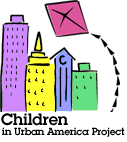A Brief History of Children in Urban America
"Childhood," argues Joseph Hawes, a leading historian of childhood, "is
where you can catch a culture in high relief." (Washington Post,
November 13, 1998) And in the urban spaces of the United States during
the last century and a half, where, in any given year, more than a
quarter of the population were under the age of eighteen, the
experiences of children, adult attitudes toward children, government
policies toward children, and the intersection of childhood and culture
can be studied in great detail.
American cities have been the stages for dynamic economic growth and the
scene of crushing economic hardships, the crucible of racial and class
stratification, as well as of daring social and political reforms. And
children have, of course, been at the center of it all, from a
qualitative, as well as a quantitative, point of view. Although rural
families have always tended to be larger than urban families -- in 1910, for
instance, there were 782 children per 1000 women of childbearing age in
the rural United States, but only 469 in urban areas -- the percentage of
the urban population counted as children remained high.
In 1860,
nearly 42 percent of Milwaukee residents were under the age of
fifteen; more than half were under the age of twenty. That percentage
dropped over the next several decades, but almost a third of urban
residents were under eighteen or younger in 1930, a number that held
fairly steady into the 1950s. (The percentage of youngsters in
Milwaukee County's population reflected national trends.)
But children were integral elements of urban America in many other ways,
too. Everything that happened to and for children in the second half of
the nineteenth century and in the twentieth century happened first in
the cities. When the stages of childhood and youth were extended
through compulsory education, the commercialization of entertainment and
leisure, and the reform of abusive child-labor practices, urban children
were the first beneficiaries.
As the national culture became
increasingly child- and youth-oriented, nowhere was it more apparent
than in the city. As millions of immigrants, including many children,
flowed into the United States between the Civil War and the 1930s, they
tended to crowd into urban neighborhoods, where the youngsters would
fill public schools and take up diverse street trades. As institutions
and organizations developed to meet the needs and desires of children
and youth -- ranging from social clubs to sports teams, from orphanages to
juvenile courts, from kindergartens to day cares -- they appeared first in
urban areas. As reformers fought to reduce the back-breaking hours of
hard labor performed by children in the 1910s and 1920s, they won their
first successes in urban industries. Farms were left out of the early,
halting attempts to end child labor. In many respects, then, the
history of children's experiences and of the efforts by adults to shape
and to aid children are deeply rooted in the history of American cities.
City children represented every ethnic group, every socioeconomic
strata, and every religion found in the United States. Yet we tend to
think of the "street arabs" captured in Jacob Riis' haunting
photographs of the 1890s or of the hard-working newsboys, factory hands,
or scavengers in the pictures taken by Lewis Hines a couple of decades
later.
City children, it seems, should be working class children. Yet
we know, of course, that there were also middle- and upper-class
children living in American cities. Their backgrounds not only ensured
a routine dominated by school and play -- without work -- but also better
access to health care and to toys, games, and entertainment of all
kinds. Even as, later in the century, they came to live more in suburbs
than in cities, even if they did not have to hawk newspapers or live in
cold-water tenements, the polished offspring of the "better sort" of
urbanites were still city children, caught up in its rhythms and
institutions, its hardships and fun.
David Nasaw has captured these challenges and opportunities in his
path-breaking book, Children of the City: At Work and at Play. In
his preface he offers an eloquent but not romanticized description of
the relationship between urban children and their surroundings.
"This
book," he begins, "does not take as its starting point the assumption
that the city is, has been, and must be the worst possible environment
for the young. City kids grew up without adequate air, light, and space
to play and grow, but, compared to their rural counterparts locked
inside mines, mills, and canneries or put out to work on sugar beet,
cotton, and berry fields, they were privileged. The children of the
city did not wither and die in the urban air but were able to carve out
social space of their own.
"They converted streets, stoops, sidewalks,
alleyways, and the city's wastelands into their playgrounds. As they
reached the age of ten or eleven, they went to work in their downtown
business, shopping, and entertainment districts where, every afternoon
after school, they scavenged for junk, blacked boots, peddled gum,
candy, and handkerchiefs, and hawked the latest editions of the
afternoon dailies."
Nasaw is writing about the early twentieth century, but the dynamism of
children's urban lives prevailed long before and long after the period
examined in Children of the City. The brief excerpt captures
perfectly the intersection of play and work, hardship and happiness,
that have always molded children growing up in the urban areas of the
United States.
Back to Introduction
